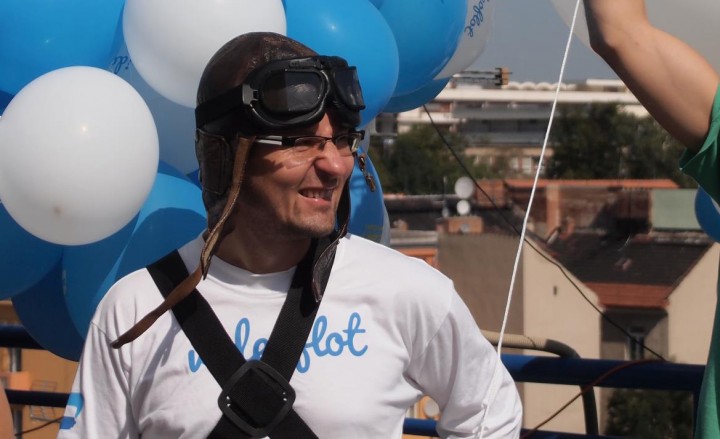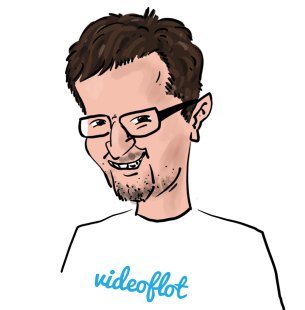A man with a lot of stories. From camels through computer games to travelling the jungle of South America in a twenty-five-year-old car made in East Germany. Meet David “Havran” Spáčil. We had a great conversation about viral videos, a Chilean start-up program, tricking big media outlets and the future of David’s startup Videoflot. Why didn’t he break through in Hollywood? Read on.
We’re finalizing the interview through e-mails, because you are now on a trip to South America. How’s the weather there? 
We’ve just arrived with Barbucha (the second videoflot team member in the Start-Up Chile program) in Santiago de Chile, it is spring here, so we were happy to escape the Czech winter. I was supposed to join the TransTrabant expedition in Guyana after setting up our office in Chile, but the expedition was delayed for a month, so we changed the plan and I’ll join them later. The goal is to travel across the whole continent in a Trabant (the legendary East German car made basically from plastic), in a Fiat Polski (another legend, this time from Poland) and with a Jawa (a vintage motorcycle). I’m one of the film crew whose aim is to film the whole thing. The guys behind the concept already conquered Africa and Asia, so they have a lot of experience. You can watch our progress on our website or on Facebook.
You will stay in South America a little longer – as you were chosen to participate in a Startup Chile program. WTF is that and what does it mean for you?
I was told Chile is probably the richest country in South America – because of its natural resources. But their government doesn’t want to be dependent on them and they would like to create a network of technological companies that would have ties with Chile. And so they created the program, which has gained quite a momentum worldwide – this time they have chosen about 100 out of 1,500 projects. This has been the fifth run: they give you the funding of about €30.000 (and they don’t want equity or anything like that in return) and the only thing you have to do is for the founder and one other team member to stay in Chile for half a year. It’s one of the most successful projects of its kind outside of major tech hubs. There’s a video of Steve Wozniak promoting it lately. I was told about it by Petr Base, who took part in it with www.bio.cz project, so we decided to give it a try.
You applied with your project called Videoflot. If I get it right, it is a social network for all kinds of people involved around film and video production.
I don’t really call it a social network. I’ve been around video for a long time and I saw the field had been going through a significant change. The number of inquiries has grown rapidly and at the same time, there are many freelance newcomers that used to do it just for fun and now they have learned they can earn some money. Meanwhile the veterans often left agencies and went off on their own. The cost of equipment lowered too. So I saw a need for a platform to meet others and to create ad hoc teams for particular contracts. There isn’t anything like that – just some webs for amateur film makers, but that’s not what I was looking for. I describe Videoflot as a creative playground and a marketplace for video production. And I haven’t found it in any other countries, so we decided to go international from the very start.
I always worry about the Catch 22 problem: you need to get the creators, so you can lure the people who would fill the jobs. And they won’t come unless there are plenty of creators to choose from. How can this vicious circle be broken?
I agree. In the beginning the easier task is to get the creators. They need jobs, they know each other and they will follow once a couple of influencers join. It’s harder to get the people that would need videos. We will go out to NGOs, music groups and entrepreneurs and let them know about it. We also count on viral video, since that can help us get the attention in an effective way and it’s cheaper than to spend tons of money on ads. And I hope I can claim we have quite some experience with that.
So as a video creator, will have I there some kind of portfolio, too?
Yep, a profile with a portfolio. The basic profile (startflot) is free (if you want to use it for non-commercial purposes); if you would like to get jobs, you will have to upgrade to a paid profile (superflot). So not a percentage of a deal, but a classic freemium model. The price for a paid profile will be around €20/month – now in beta you can try it for free.
How many people are there in the community? In the Czech Republic for a start.
It’s just an estimate, a rough estimate, OK? But it’s 20 to 50 thousand. It’s not just the guys with a camera, but the whole chain – from pre-production (script, storyboards, casting) through directors, cameramen, to post-production (cut, animators, dubbing, sound) – it could be even more and most importantly, the number is still growing. Based on ReelSEO.com the growth potential is over 50% a year.
Your plan is to start not just in the Czech Republic. But here you – as a guy from the community – know where to look for the influencers. Abroad you are lacking the social network. How do you want to tackle that?
We thought about doing it for the Czech Republic only and expand once it proves itself. But we decided to go global. I believe the localization is one of the key points. But the main thing is that it brings value to its users and it’s simple and intuitive. We believe the right tactic is to do the marketing in the way Dieter Mateschitz does it (I’m sure almost everyone saw Felix and his jump). We like such kinds of productions (though on a very different budget). How to spread the word about a server for creative video folks if not with viral videos?
Videoflot launched a few weeks ago. Can you tell us how many people have joined so far? Are they mainly from the Czech Republic/Slovakia or do you have people from different countries too?
There are over 500 creators and film makers and there have been about 30 projects already completed through Videoflot (and the same number of them is in progress). We have had quite a lot of media coverage (in the Czech Republic).
It’s not the first project I have spoken about with you. But the difference this time is that you went through with StarCube in JIC (a startup incubator in Brno, Czech Republic) and „full-time“.
I believe all the projects I went through with, though some of them might not have been very successful, were worth it. I guess it sounds like a cliché, but you still learn a lot. But this time I knew I wanted to really focus on it and start in a professional way – there were two major points, funding from the Open Society Fund and successful application to StarCube. The latter one was quite a coincidence – I called a friend of mine, Adam Hazdra, with whom I wanted to discuss our business plan and he mentioned StarCube. The deadline for the application was the same day, but since I had most of the materials needed ready, I quickly summed up the rest and applied – and we made it.
What would you name as the main benefit of StarCube?
It’s for three months, filled with a lot of work. We had a place to stay – which is not that important after all – but you share this space with other teams that often have to solve similar issues. And there are many other people you can talk to – different mentors and partners. So it’s the contacts and the people.
If you could name one or two mentors that really changed something in your thinking or in the project itself, who would they be?
There was a bunch of them, to name one is really hard, but for example Jan Všianský gave us some really useful advice at the very beginning.
Let’s take a step back – when you look at your career or path – were there some major changes? Let’s say from university to Chile…
Hm… I guess I’ve just recently realized how I function in my life. I used to be confused about it. I think I have quite wide and open horizons of knowledge and interests. That’s cool, but the downside is that I know too little about all these things. And from time to time, I suddenly change my course. As a kid, I was an avid fan of two subjects: zoology and arts (the visual part ). And somehow I’ve been following these two all my life. I have my first academic degree from Mendel University (the theme of my thesis was the ethology of camels) and then I worked in a zoo in Olomouc for a year as a caretaker of African hoofed animals. But I wanted to succeed in the movie industry, so in the 90s I went to the USA with a bunch of sketches and I used to try to sneak into the studios (Disney, Fox) with my drawings. They really liked me, but the problem was getting the green card. I slept on a bus station in Hollywood with hobos – it was like that for four months, and then I gave up.
Back home I switched and started to work in the gaming industry. In Altar Interactive, where I spent the next seven years, I was one of the founding members. Some of the titles I worked on include Fish Fillets, Original War, UFO: Aftermath and others. I was in charge of graphic artists and once I went to FaVU (the Faculty of Arts, Technical University in Brno) to look for new talent. I spotted some application forms, and filled them, not really thinking about it. I was already 27, but I thought I might give it a try. It was video/multimedia studies, and eventually I made it – even though they only chose three people out of 150 and almost all the others had the proper background, I used to study camels, so I knew nothing about art history. It was kind of funny. And I spent the next seven years there. First I studied video art/multimedia, then I switched to Václav Stratil’s studio (drawing – but it ended up as intermedia).
We met for the first time because of Videodrom – it was supposed to be a database of all Czech and Slovak music videos.
A typical example of a “living dead” project. There are about 3,500 entries, mostly music videos, but I don’t care about it anymore, nor does anyone else. It was a side-product of my MA thesis. It’s not working well anymore. Too bad. We might fix it if there’s the time and will to do it.
I think many people know about your videos, much more than about you or Videoflot. Your last hit was a viral video “Biker on a highway”. It reached TV, newspapers and even made its appearance on Gizmodo.
I was told it was screened on Portuguese and Polish TV too. DailyNews and Gizmodo were the most important foreign internet outlets.
How does it happen – what is the secret viral ingredient?
That’s a tricky thing. Often there’s something out of control, some strange factor from the outside you don’t really plan. It’s also the case with the biker. The video was prepared, but it was supposed to be seeded in a different way. By accident it got uploaded to the wrong destination by an agency that was helping the product guys (the bike company 4Ever) with graphics. It got about 12 thousand views and they panicked as it wasn’t supposed to be released at that time, so they deleted it. We of course uploaded it again, and in the end I think it actually helped the whole thing since people believed it was real – who would delete it if it was meant to be a viral video?
Viral videos… Even if it spreads like wildfire, it usually doesn’t carry the brand message itself and the brand behind is not seen. Then you have to make some kind of sequel or otherwise connect it with the message you want to deliver. What about the biker and the ROI?
The original video reached over two millions views and there were many positive reactions. The making of has 20k views on YouTube and almost 100k views on Vimeo. The bike company’s website traffic rose hundreds of percent.
You made some viral videos before. Would you share some more insights?
I have been interested in virals in general. I also study them from a slightly more academic perspective. I tried to create a video reflecting an actual event – when Barbora Tacheci (ex-boss of the Czech Radio 1) got crazy in a TV interview, I did a mash-up of her and Crazy Frog, and it hit the prime time on the most widely watched Czech TV (Nova). The other one was about the craze connected with Jozin z bazin (an old Czech song that made it big especially in Poland). These had reached millions of views before they got deleted (what you can see now are re-uploads).
So do you think it’s more about luck or is it possible to create a video you know will be a viral hit?
I think you can include some “buttons of buzz” that set the viral spreading… It could be a certain level of doubt about whether the thing is real (ideally on the very edge, so people can argue about it), it is certainly a fun moment, forbidden fruit (banned ads, stuff that is somehow politically incorrect) – it’s hard to plan and you have to feel it somehow. You must have great channels ready for sharing. Plus you certainly need to be lucky, that makes the difference between a limited and a huge success. And the situation is changing – because of previous virals. People have got suspicious, since now they see a video and their first thought is: ah, that’s got to be a commercial attempt created for a brand, I wonder who’s behind it. But on the other hand – in such a situation, there is a space for these “making of” videos as people want to know how it was done.
Still most of the virals are not big hits. What goes wrong in the case of companies that badly want to have one created, but it doesn’t work out?
I think it’s because the companies try to create ads. They want the product to be seen, and that’s wrong, though understandable. In the end it’s quite simple – as the producer or the company, you should ask: if I saw this video on Facebook, would I share it? If not, then it’s not good enough. I think the way to get ahead is to step aside, think of a story that would carry the idea behind the brand and put all the focus on the story. Then it will work. You should create a video that shares the idea, not depicts the product. And then there are funny commercials that people like to send to their friends. But that’s a different genre.
Do you have any favorite examples of a company that uses virals in a successful way?
I have two big time favorites: Will It Blend? and Red Bull.
And then there are things like Debilni kecy (a copycat idea based on “Shit girls say”) – they appeal to an audience of natural born clickers (they do share a lot). But I think the connection of the idea behind the video and the product it intends to sell is too vague. Actually the last sequel Debilni kecy na dovolene has a good tagline and this one works.
If there was a deal coming your way – you have 40k euros to create the most viral video we have seen in a long time. For a bank. Would you do it?
Well, why not. I believe you can create a great viral video for almost any product. I’m actually working now on a series of viral videos I cannot really talk about much. But the client is probably as unattractive as the bank industry would be. One would say you can’t really create anything for these guys but I’m pretty sure it will work well.
What’s the budget?
Around 4,000 euros. A Czech client.
Your launch was kind of a viral show too…
Well, it was a live stream – as we are a video related website… It showed me standing on the top of one of the tallest building in Brno in a special costume with helium balloons. There was a like button and for each like VideoFlot got on Facebook, I added one more helium balloon – until there were so many of them, that I started to float away. And then we launched it. You can see the video covering the launch:
OK, safe flight! Enjoy Chile and good luck with VideoFlot!
Five tips from David Spáčil
-
Don’t be a di*k – this covers basically everything…
-
Do what you love – even if you don’t have the money and you struggle sometimes. It will pay off in the end.
-
Every time you want to create a viral – think about whom you would send it. If you wouldn’t do it, you have a video, but certainly not a viral one.
-
When it comes to start-ups, do the tough decision in the beginning. Do you want to earn some cash or do you want to change the world? If it is just about the money, go ahead and copy something – sell ties in a tin, it would be cool and you can get some quick money. But if you go for the big change, forget about the money. Page and Brin, Zuckerberg and many others didn’t thought about it either. If they did, the risk evaluation would be too grim for them to even try.
-
Find a dream team. You need people better than you (and reliable). And don’t care about lists of tips, make your own way!
the video community master
vimeo.com/havran
- @videoflot
- davidspacil
- videoflot











